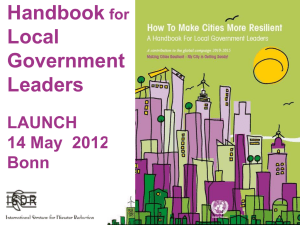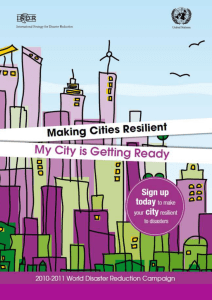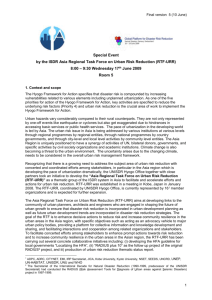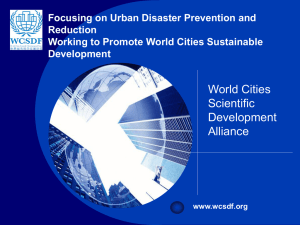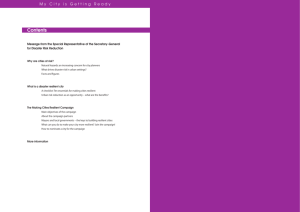Making Cities Resilient
advertisement
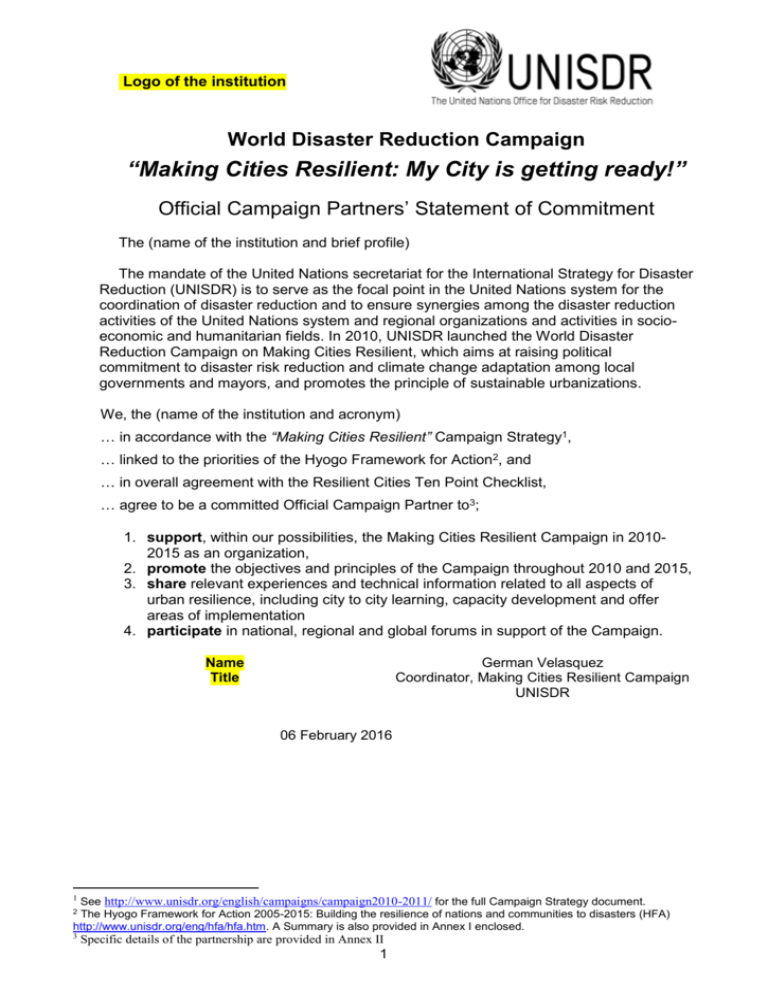
Logo of the institution World Disaster Reduction Campaign “Making Cities Resilient: My City is getting ready!” Official Campaign Partners’ Statement of Commitment The (name of the institution and brief profile) The mandate of the United Nations secretariat for the International Strategy for Disaster Reduction (UNISDR) is to serve as the focal point in the United Nations system for the coordination of disaster reduction and to ensure synergies among the disaster reduction activities of the United Nations system and regional organizations and activities in socioeconomic and humanitarian fields. In 2010, UNISDR launched the World Disaster Reduction Campaign on Making Cities Resilient, which aims at raising political commitment to disaster risk reduction and climate change adaptation among local governments and mayors, and promotes the principle of sustainable urbanizations. We, the (name of the institution and acronym) … in accordance with the “Making Cities Resilient” Campaign Strategy1, … linked to the priorities of the Hyogo Framework for Action2, and … in overall agreement with the Resilient Cities Ten Point Checklist, … agree to be a committed Official Campaign Partner to3; 1. support, within our possibilities, the Making Cities Resilient Campaign in 20102015 as an organization, 2. promote the objectives and principles of the Campaign throughout 2010 and 2015, 3. share relevant experiences and technical information related to all aspects of urban resilience, including city to city learning, capacity development and offer areas of implementation 4. participate in national, regional and global forums in support of the Campaign. Name Title German Velasquez Coordinator, Making Cities Resilient Campaign UNISDR 06 February 2016 1 See http://www.unisdr.org/english/campaigns/campaign2010-2011/ for the full Campaign Strategy document. The Hyogo Framework for Action 2005-2015: Building the resilience of nations and communities to disasters (HFA) http://www.unisdr.org/eng/hfa/hfa.htm. A Summary is also provided in Annex I enclosed. 2 3 Specific details of the partnership are provided in Annex II 1 Goal and objectives of the Making Cities Resilient Campaign The goal is to promote that local governments: Know more, by raising awareness of citizens and governments at all levels of the benefits of reducing urban risks. Invest wisely, by identifying budget allocations within local government funding plans to invest in disaster risk reduction activities. Build more safely, by including disaster risk reduction in participatory urban development planning processes and protect lives and critical infrastructure. Overall, the Campaign seeks to raise awareness and effect change by urging local governments to take immediate action, and to build multi-stakeholder partnerships to achieve the implementation of the Hyogo Framework for Action at the local level, by working together with local organizations, grass root networks, private sector and national authorities. The attached ten-point checklist of “essentials” for making cities resilient – not to be exhaustive – will serve as a guide for commitment during the Campaign (see annex 1). The goal of the Making Cities Resilient campaign is to increase substantially the number of cities and local governments who are aware and taking action to reduce disaster risk; as well as to raise the profile of local governments in their risk reduction, preparedness and recovery efforts. This can be achieved through building long-lasting partnerships, including some of the following actions: Five Actions that the “Making Cities Resilient” campaign will develop and support 1. Raise the commitment to sustainable urbanization, which will reduce disaster risk for all spheres of government and contribute to all levels of decision-making 2. 3. How? Set up advisory and steering groups, fostering local an national alliances. How? To Inform Raise awareness of urban disaster risk and inform people how local governments and citizens can address risk as part of their development planning, building safer schools and hospitals and strengthening local government services 4. Organize roundtables and policy dialogues among national and local authorities at national, regional and international forums, led by mayors, with the goal of getting national and local “compacts” of commitment to strengthen capacities in disaster risk reduction to strengthen capacities in disaster risk reduction. Create the political space for local actors. To Connect Build partnerships between local and national authorities, along with local actors, civil society groups, academia and expert organizations Organize public meetings, begin dialogues, promote drills and local events, hold high-profile events and involve the media, pledge to safer schools and hospitals (web pledging system) and plan other public awareness activities such as awards, role model cities and champions How? To Learn Increase knowledge and improve access to tools, technology and capacity development opportunities for local governments and local actors 5. How? To Convince In collaboration with researchers, practitioners, training centres and role-model cities, apply the handbook for local governments, by providing city-to-city learning, training, technical cooperation and guidance. How? To Measure Progress Communicate the progress and successes of local governments in achieving the Ten Steps for City Resilience Be part of the global reporting on HFA supporting cities in implementing the Local Government Self Assessment Toll (LG-SAT) collecting and sharing good 2 practice and experiences 3 Annex I Ten Essentials for Making Cities Resilient The campaign proposes a checklist of Ten Essentials for Making Cities Resilient that can be implemented by mayors and local governments. The checklist derives from the five priorities of the Hyogo Framework for Action 2005-2015: Building the Resilience of Nations and communities to disasters, a key instrument for implementing disaster risk reduction. Achieving all, or even some, of these ten essentials will help cities to become more resilien t. 1. Put in place organization and coordination to understand and reduce disaster risk, based on participation of citizen groups and civil society. Build local alliances. Ensure that all departments understand their role to disaster risk reduction and preparedness. 2. Assign a budget for disaster risk reduction and provide incentives for homeowners, low‐income families, communities, businesses and public sector to invest in reducing the risks they face. 3. Maintain up‐to‐date data on hazards and vulnerabilities, prepare risk assessments and use these as the basis for urban development plans and decisions. Ensure that this information and the plans for your city’s resilience are readily available to the public and fully discussed with them. 4. Invest in and maintain critical infrastructure that reduces risk, such as flood drainage, adjusted where needed to cope with climate change. 5. Assess the safety of all schools and health facilities and upgrade these as necessary. 6. Apply and enforce realistic, risk‐compliant building regulations and land use planning principles. Identify safe land for low‐income citizens and develop upgrading of informal settlements, wherever feasible. 7. Ensure education programmes and training on disaster risk reduction are in place in schools and local communities. 8. Protect ecosystems and natural buffers to mitigate floods, storm surges and other hazards to which your city may be vulnerable. Adapt to climate change by building on good risk reduction practices. 9. Install early warning systems and emergency management capacities in your city and hold regular public preparedness drills. 10. After any disaster, ensure that the needs of the survivors are placed at the centre of reconstruction with support for them and their community organizations to design and help implement responses, including rebuilding homes and livelihoods. 4 Annex II Partnership Activities In the context of this partnership, (name of the institution) undertakes to: - Please identify past, current and future campaign activities 1. 2. 3. Focal point information Please fill in UNISDR focal point information German Velasquez Coordinator, Making Cities Resilient Campaign UNISDR - 5
